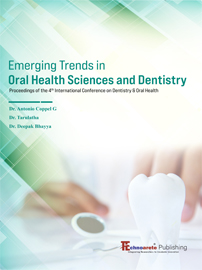


Department of Conservative dentistry and Endodontics, Chettinad dental college and research institute, Kanchipuram,India, 603103;
Corresponding Author: sreema1995@gmail.com
Department of Conservative dentistry and Endodontics, Chettinad dental college and research institute, Kanchipuram,India, 603103;
Corresponding Author: Dr.anupama@gmail.com
Department of Conservative dentistry and Endodontics, Chettinad dental college and research institute, Kanchipuram,India, 603103;
Corresponding Author: drsadasiva@yahoo.co.in
Department of Conservative dentistry and Endodontics, Chettinad dental college and research institute, Kanchipuram,India, 603103;
Corresponding Author: sankardr20@gmail.com
The major objective behind the endodontic therapy is to primarily decrease the microbial load from the infectious root canal system by meticulous bio-mechanical preparation followed by a fluid impervious obturation in order to offer a favourable environment for the periapical healing. Every clinical procedure while performing endodontic therapy requires maximum flawlessness, few of the examples are estimation of working length accurately, meticulous biomechanical preparation with sufficient usage of intracanal irrigants and medicaments, and with the advanced magnifying aids like dental loupes and microscopes. Despite performing the endodontic therapy diligently, the post-endodontic pain prevalence is not uncommon and is fairly high. The post-endodontic pain is an unpleasing sensation yet a common occurrence in the clinical grounds that greatly affects the standard of relationship between the patients and doctor. (1)
[1] Rosenberg PA. “Clinical strategies for managing endodontic pain”. Endodontic Topics 3 (2002): 78-92.
[2] Sathorn C., et al. “The prevalence of postoperative pain and flare- up in single-visit and multiple-visit endodontic treatment: a systematic review”. International Endodontic Journal 41.2 (2008): 91-99
[3] Pak JG and White SN. “Pain Prevalence and severity before, during, and after root canal treatment: a systematic review”. Journal of Endodontics 37.4 (2011): 429-438.
[4] Pak JG and White SN. “Pain Prevalence and severity before, during, and after root canal treatment: a systematic review”. Journal of Endodontics 37.4 (2011): 429-438.
[5] Sipaviciute, E., Manelien_e, R., 2014. Pain and flare-up after endodontic treatment procedures. Baltic Dental Maxillofacial J. 16, 25–30
[6] Seltzer S. “Pain in endodontics”. Journal of Endodontics 30.7 (2004): 501-503.
[7] Ali A., et al. “Influence of preoperative pain intensity on postoperative pain after root canal treatment: a prospective clinical study”. Journal of Dentistry 45 (2016): 39-42
[8] Alves Vde O. “Endodontic flare-ups: a prospective study”. Oral Surgery Oral Medicine Oral Pathology Oral Radiology and Endodontics 110.5 (2010): e68-e72.7.
[9] Attar S., et al. “Evaluation of pretreatment analgesia and endodontic treatment for postoperative endodontic pain”. Journal of Endodontics 34.6 (2008): 652-655
[10]Pochapski MT., et al. “Effect of pretreatment dexamethasone on postendodontic pain”. Oral Surgery Oral Medicine Oral Pathology Oral Radiology and Endodontics 108.5 (2009): 790-795.
[11]Pochapski MT., et al. “Effect of pretreatment dexamethasone on postendodontic pain”. Oral Surgery Oral Medicine Oral Pathology Oral Radiology and Endodontics 108.5 (2009): 790-795.
[12]PDina Al-Sudani., et al. “Incidence and intensivity of postoperative pain and periapical inflammation after endodontic treatment with two different instrumentation techniques”. European Journal of Inflammation 10.1 (2012): 99-103.
[13]Parirokh M., et al. “Effect of occlusal reduction on postoperative pain in teeth with irreversible pulpitis and mild tenderness to percussion”. Journal of Endodontics 39.1 (2013): 1-5.
[14] Modabber A, Rana M, Ghassemi A, et al. Three-dimensional evaluation of postoperative swelling in treatment of zygomatic bone fractures using two different cooling therapy methods: a randomized, observer–blind, prospective study. Trials 2013;14:238.
[15]. Swenson C., et al. “Cryotherapy in sports medicine”. Scandinavian Journal of Medicine and Science in Sports 6.4 (1996): 193- 200.
[16] Watkins AA., et al. “Ice packs reduce postoperative midline incision pain and narcotic use: a randomized controlled trial”. Journal of American College of Surgeons 219.3 (2014): 511-517.
[17] Kwekkeboom KL. “Pain management strategies used by patients with breast and gynecologic cancer with postoperative pain”. Cancer Nursing 24.5 (2001): 378-386.
[18] McDowell JH., et al. “Use of cryotherapy for orthopaedic patients”. Orthopedic Nursing 13.5 (1994): 21-30.
[19]Koc M., et al. “Cooling for the reduction of postoperative pain: prospective randomized study”. Hernia: The Journal of Hernias and Abdominal Wall Surgery 10.2 (2006): 184- 186. 21
[20]Arnott J. Practical illustrations of the remedial efficacy of a very low or anaesthetic temperature. I. In cancer. Lancet 1850; 2: 257-259